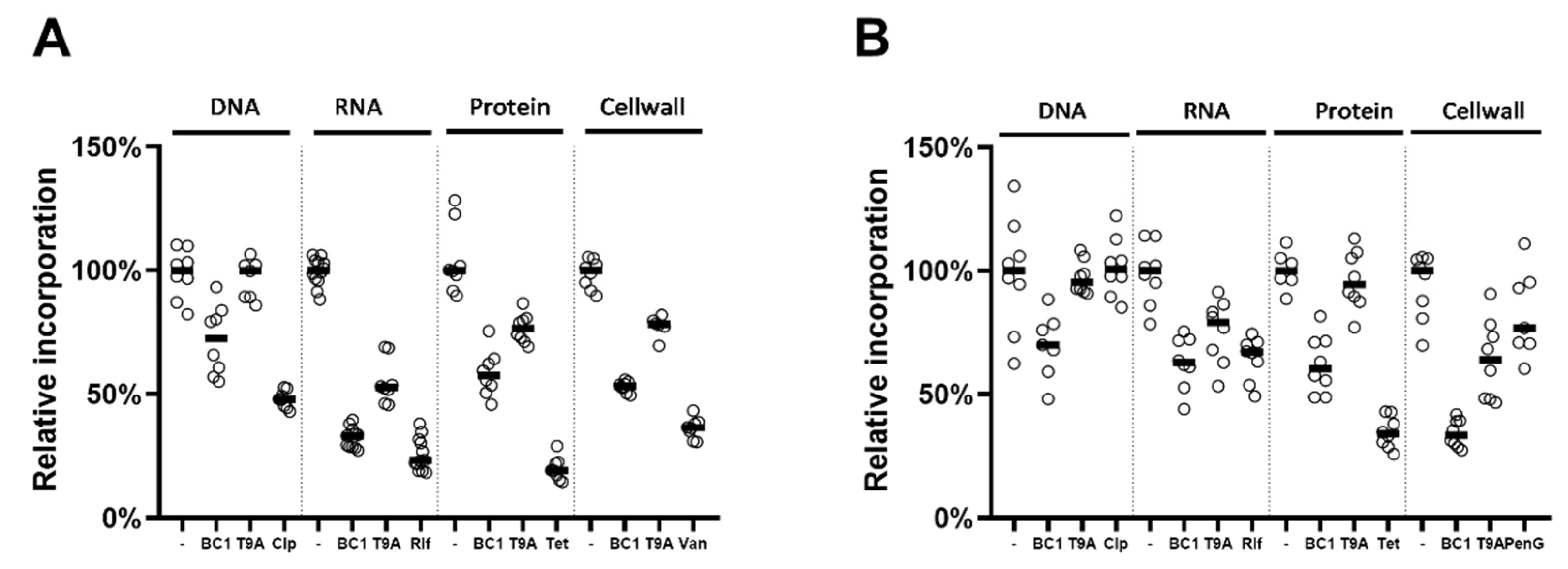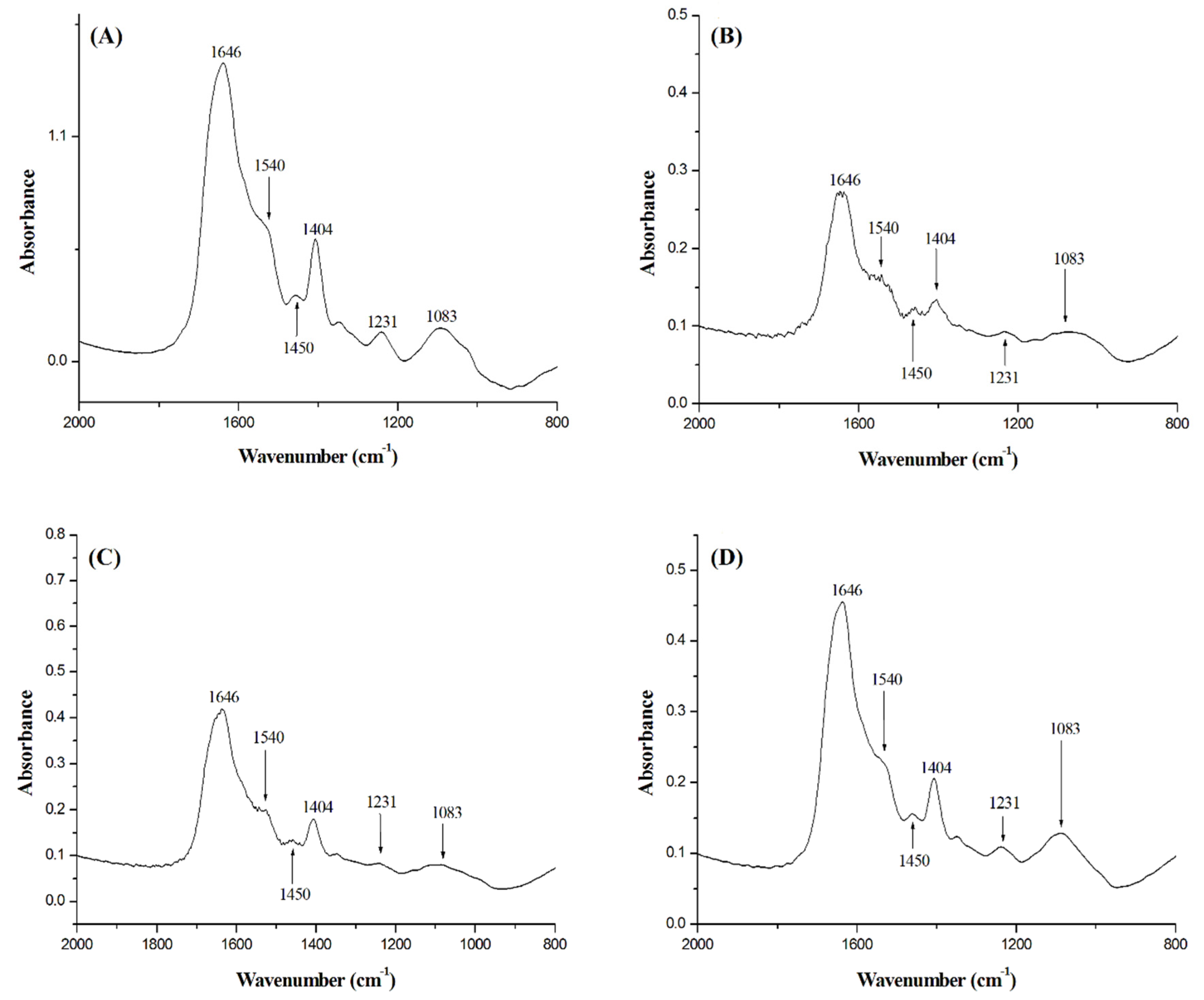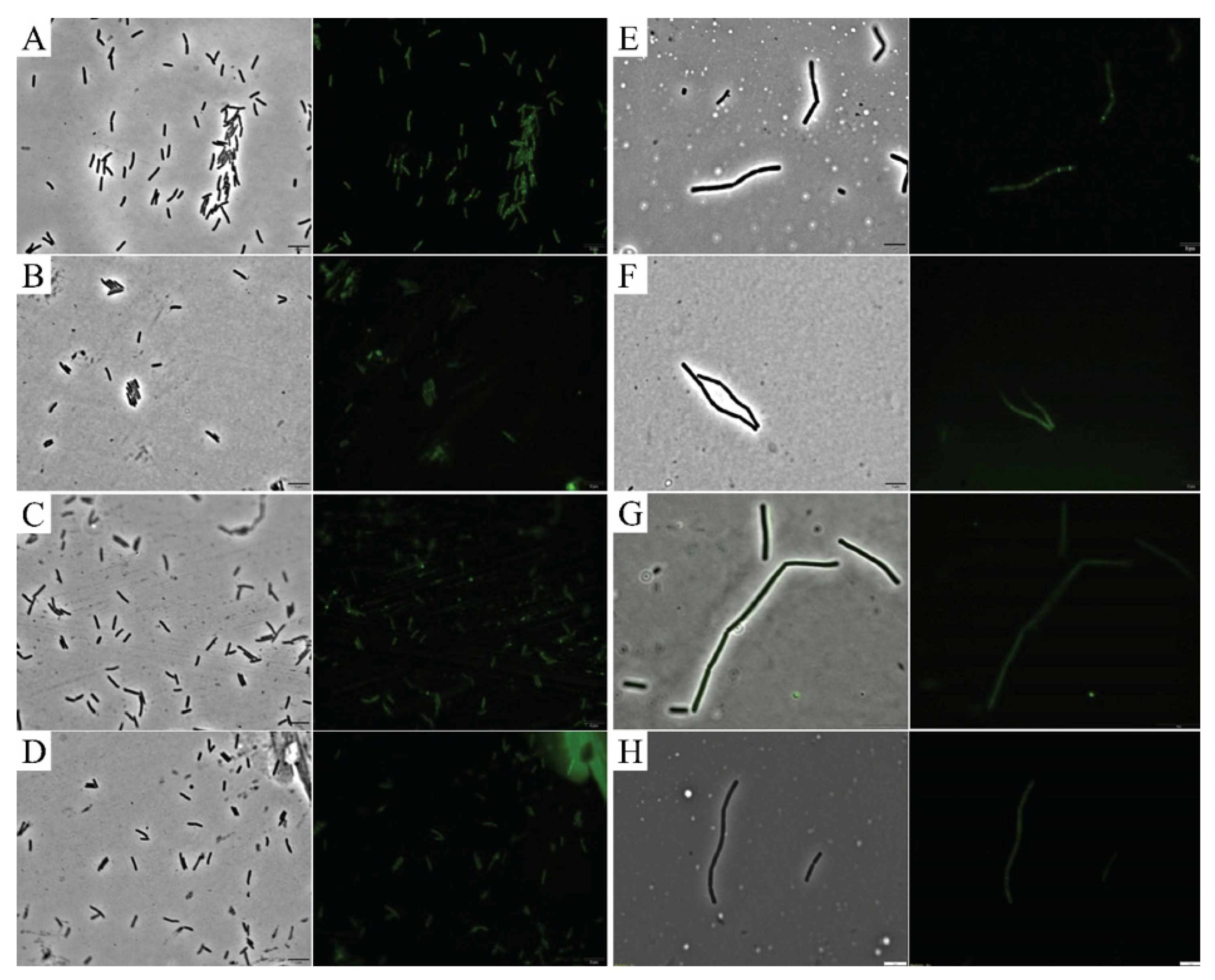Investigating the Modes of Action of the Antimicrobial Chalcones BC1 and T9A
Abstract
1. Introduction
2. Results
2.1. Chalcones Inhibit Growth of X. citri and B. subtilis
2.2. BC1 Permeabilizes the Membrane of B. subtilis
2.3. Effects on Macromolecular Synthesis
2.4. Effects on Metabolic Activity and ATP Levels
2.5. FT-IR Spectrophotometry
2.6. Cell Division Investigations
3. Discussion
4. Materials and Methods
4.1. Chemical Synthesis
4.2. Minimal Inhibitory Concentration Assays
4.3. Membrane Permeability Assay
4.4. Macromolecular Synthesis
4.5. Resazurin Assay
4.6. Intracellular ATP Concentration Assay
4.7. FT-IR Spectrophotometry
4.8. Cell Division Interference
5. Conclusions
Supplementary Materials
Author Contributions
Funding
Acknowledgments
Conflicts of Interest
References
- Gottwald, T.R.; Graham, J.H.; Schubert, T.S. Citrus Canker: The Pathogen and Its Impact. Plant Heal. Prog. 2002, 3, 15. [Google Scholar] [CrossRef]
- Behlau, F.; Gochez, A.M.; Jones, J.B. Diversity and copper resistance of Xanthomonas affecting citrus. Trop. Plant. Pathol. 2020, 45, 1–13. [Google Scholar] [CrossRef]
- Behlau, F.; Canteros, B.I.; Minsavage, G.V.; Jones, J.B.; Graham, J.H. Molecular Characterization of Copper Resistance Genes from Xanthomonas citri subsp. citri and Xanthomonas alfalfae subsp. citrumelonis. Appl. Environ. Microbiol. 2011, 77, 4089–4096. [Google Scholar] [CrossRef] [PubMed]
- Nunes, I.; Samuel, J.; Brejnrod, A.; Holm, P.E.; Johansen, A.; Brandt, K.K.; Priemé, A.; Sørensen, S.J. Coping with copper: Legacy effect of copper on potential activity of soil bacteria following a century of exposure. FEMS Microbiol. Ecol. 2016, 92, 175. [Google Scholar] [CrossRef] [PubMed]
- Katsori, A.M.; Hadjipavlou-Litina, D. Recent progress in therapeutic applications of chalcones. Expert Opin. Ther. Patents 2011, 21, 1575–1596. [Google Scholar] [CrossRef]
- Nielsen, S.F.; Larsen, M.; Boesen, T.; Schønning, K.; Kromann, H. Cationic chalcone antibiotics. design, synthesis, and mechanism of action. J. Med. Chem. 2005, 48, 2667–2677. [Google Scholar] [CrossRef]
- Haraguchi, H.; Tanimoto, K.; Tamura, Y.; Mizutani, K.; Kinoshita, T. Mode of antibacterial action of retrochalcones from Glycyrrhiza inflata. Phytochemistry 1998, 48, 125–129. [Google Scholar] [CrossRef]
- Tsukiyama, R.I.; Katsura, H.; Tokuriki, N.; Kobayashi, M. Antibacterial activity of licochalcone a against spore-forming bacteria. Antimicrob. Agents Chemother. 2002, 46, 1226–1230. [Google Scholar] [CrossRef]
- Zhou, B.; He, Y.; Zhang, X.; Xu, J.; Luo, Y.; Wang, Y.; Franzblau, S.G.; Yang, Z.; Chan, R.J.; Liu, Y.; et al. Targeting mycobacterium protein tyrosine phosphatase B for antituberculosis agents. Proc. Natl. Acad. Sci. USA 2010, 107, 4573–4578. [Google Scholar] [CrossRef]
- Barreca, D.; Bellocco, E.; Laganà, G.; Ginestra, G.; Bisignano, C. Biochemical and antimicrobial activity of phloretin and its glycosilated derivatives present in apple and kumquat. Food Chem. 2014, 160, 292–297. [Google Scholar] [CrossRef]
- Abdullah, M.I.; Mahmood, A.; Madni, M.; Masood, S.; Kashif, M. Synthesis, characterization, theoretical, anti-bacterial and molecular docking studies of quinoline based chalcones as a DNA gyrase inhibitor. Bioorganic Chem. 2014, 54, 31–37. [Google Scholar] [CrossRef] [PubMed]
- Valavanidis, A.; Vlachogianni, T. Plant polyphenols: Recent advances in epidemiological research and other studies on cancer prevention. Stud. Nat. Prod. Chem. 2013, 39, 269–295. [Google Scholar]
- Polaquini, C.R.; Morão, L.G.; Nazaré, A.C.; Torrezan, G.S.; Dilarri, G.; Cavalca, L.B.; Campos, D.L.; Silva, I.C.; Pereira, J.A.; Scheffers, D.J.; et al. Antibacterial activity of 3,3′-dihydroxycurcumin (DHC) is associated with membrane perturbation. Bioorg. Chem. 2019, 90, 103031. [Google Scholar] [CrossRef]
- Morão, L.G.; Polaquini, C.R.; Kopacz, M.; Torrezan, G.S.; Ayusso, G.M.; Dilarri, G.; Cavalca, L.B.; Zielińska, A.; Scheffers, D.; Regasini, L.O.; et al. A simplified curcumin targets the membrane of Bacillus subtilis. Microbiol. Op. 2018, 8, e00683. [Google Scholar] [CrossRef]
- Savietto, A.; Polaquini, C.R.; Kopacz, M.; Scheffers, D.J.; Marques, B.C.; Regasini, L.O.; Ferreira, H. Antibacterial activity of monoacetylated alkyl gallates against Xanthomonas citri subsp. citri. Arch. Microbiol. 2018, 200, 929–937. [Google Scholar] [CrossRef] [PubMed]
- Nazaré, A.C.; Polaquini, C.R.; Cavalca, L.B.; Anselmo, D.B.; Calmon, M.D.F.; Monteiro, D.A.; Zielinska, A.; Rahal, P.; Gomes, E.; Scheffers, D.J.; et al. Design of antibacterial agents: Alkyl dihydroxybenzoates against Xanthomonas citri subsp. citri. Int. J. Mol. Sci. 2018, 19, 3050. [Google Scholar] [CrossRef] [PubMed]
- Haranahalli, K.; Tong, S.; Ojima, I. Recent advances in the discovery and development of antibacterial agents targeting the cell-division protein FtsZ. Bioorganic Med. Chem. 2016, 24, 6354–6369. [Google Scholar] [CrossRef]
- Tripathy, S.; Sahu, S.K. FtsZ inhibitors as a new genera of antibacterial agents. Bioorganic Chem. 2019, 91, 103169. [Google Scholar] [CrossRef]
- Tol, M.B.; Angeles, D.M.; Scheffers, D.J. In Vivo Cluster Formation of Nisin and Lipid II Is Correlated with Membrane Depolarization. Antimicrob. Agents Chemother. 2015, 59, 3683–3686. [Google Scholar] [CrossRef][Green Version]
- Lorenzoni, A.S.G. Developing a Tool Set to Investigate Antimicrobial Mode of Action in a Phytopathogen. Ph.D. Thesis, University of Groningen, Groningen, The Netherlands, February 2019. [Google Scholar]
- Garip, S.; Gozen, A.C.; Severcan, F. Use of Fourier transform infrared spectroscopy for rapid comparative analysis of Bacillus and Micrococcus isolates. Food Chem. 2009, 113, 1301–1307. [Google Scholar] [CrossRef]
- Rigano, L.A.; Siciliano, F.; Enrique, R.; Sendín, L.; Filippone, P.; Torres, P.S.; Qüesta, J.; Dow, J.M.; Castagnaro, A.P.; Vojnov, A.A.; et al. Biofilm formation, epiphytic fitness, and canker development in Xanthomonas axonopodis pv. citri. Mol. Plant. Microb. Interac. 2007, 20, 1222–1230. [Google Scholar] [CrossRef] [PubMed]
- Da Silva, I.; Regasini, L.O.; Petrônio, M.S.; Silva, D.H.S.; Bolzani, V.D.S.; Belasque, J.; Sacramento, L.V.S.; Ferreira, H. Antibacterial activity of alkyl gallates against Xanthomonas citri subsp. citri. J. Bacteriol. 2012, 195, 85–94. [Google Scholar] [CrossRef] [PubMed]
- Strahl, H.; Hamoen, L.W. Membrane potential is important for bacterial cell division. Proc. Natl. Acad. Sci. USA 2010, 107, 12281–12286. [Google Scholar] [CrossRef] [PubMed]
- Chiriac, A.I.; Kloss, F.; Krämer, J.; Vuong, C.; Hertweck, C.; Sahl, H.G. Mode of action of closthioamide: The first member of the polythioamide class of bacterial DNA gyrase inhibitors. J. Antimicrob. Chemother. 2015, 70, 2576–2588. [Google Scholar] [CrossRef]
- Müller, A.; Wenzel, M.; Strahl, H.; Grein, F.; Saaki, T.N.V.; Kohl, B.; Siersma, T.; Bandow, J.E.; Sahl, H.G.; Schneider, T.; et al. Daptomycin inhibits cell envelope synthesis by interfering with fluid membrane microdomains. Proc. Natl. Acad. Sci. USA 2016, 113, E7077–E7086. [Google Scholar] [CrossRef] [PubMed]
- Elnakady, Y.A.; Chatterjee, I.; Bischoff, M.; Rohde, M.; Josten, M.; Sahl, H.G.; Herrmann, M.; Müller, R. Investigations to the antibacterial mechanism of action of kendomycin. PLoS ONE 2016, 11, e0146165. [Google Scholar] [CrossRef]
- Cherrington, C.A.; Hinton, M.; Chopra, I. Effect of short-chain organic acids on macromolecular synthesis in Escherichia coli. J. Appl. Bacteriol. 1990, 68, 69–74. [Google Scholar] [CrossRef]
- Nakano, M.M.; Zuber, P. Anaerobic growth of a “strict aerobe” (Bacillus subtilis). Annu. Rev. Microbiol. 1998, 52, 165–190. [Google Scholar] [CrossRef]
- Ohwada, T.; Sagisaka, S. An immediate and steep increase in ATP concentration in response to reduced turgor pressure in Escherichia coli B. Arch. Biochem. Biophys. 1987, 259, 157–163. [Google Scholar] [CrossRef]
- Santos, M.B.; Pinhanelli, V.C.; Garcia, M.A.R.; Silva, G.; Baek, S.J.; França, S.C.; Fachin, A.L.; Marins, M.; Regasini, L.O. Antiproliferative and pro-apoptotic activities of 2′- and 4′-aminochalcones against tumor canine cells. Eur. J. Med. Chem. 2017, 138, 884–889. [Google Scholar] [CrossRef]
- Kobelnik, M.; Ferreira, L.M.B.; Regasini, L.O.; Dutra, L.A.; Bolzani, V.D.S.; Ribeiro, C.A. Thermal study of chalcones. J. Therm. Anal. Calorim. 2018, 132, 425–431. [Google Scholar] [CrossRef]
- Davis, B.D.; Mingioli, E.S. Mutants of Escherichia coli requiring methionine or vitamin b12. J. Bacteriol. 1950, 60, 17–28. [Google Scholar] [CrossRef] [PubMed]
- Somma, S.; Gastaldo, L.; Corti, A. Teicoplanin, a new antibiotic from Actinoplanes teichomyceticus nov. sp. Antimicrob. Agents Chemother. 1984, 26, 917–923. [Google Scholar] [CrossRef]
- Andrews, J.M. Determination of minimum inhibitory concentrations. J. Antimicrob. Chemother. 2001, 48, 5–16. [Google Scholar] [CrossRef] [PubMed]
- Mann, C.M.; Markham, J. A new method for determining the minimum inhibitory concentration of essential oils. J. Appl. Microbiol. 1998, 84, 538–544. [Google Scholar] [CrossRef]
- Martins, P.M.; Lau, I.F.; Bacci, M., Jr.; Belasque, J.; Amaral, A.M.D.; Taboga, S.R.; Ferreira, H. Subcellular localization of proteins labeled with GFP in Xanthomonas citri ssp. citri: Targeting the division septum. FEMS Microbiol. Lett. 2010, 310, 76–83. [Google Scholar]
- Krol, E.; Scheffers, D.J. FtsZ Polymerization assays: Simple protocols and considerations. J. Vis. Exp. 2013, e50844. [Google Scholar] [CrossRef]
- Król, E.; Borges, A.D.S.; Da Silva, I.; Polaquini, C.R.; Regasini, L.O.; Ferreira, H.; Scheffers, D.J. Antibacterial activity of alkyl gallates is a combination of direct targeting of FtsZ and permeabilization of bacterial membranes. Front. Microbiol. 2015, 6, 390. [Google Scholar] [CrossRef]
Sample Availability: Samples of the compounds BC1 and T9A are available from the authors. |







| Compound | X. citri | B. subtilis |
|---|---|---|
| BC1 | 90 * | 50 # |
| T9A | 50 * | 40 # |
| Treatment | Permeabilized X. citri Cells (Mean ± SD) | Permeabilized B. subtilis Cells (Mean ± SD) |
|---|---|---|
| Negative control | 2.38 ± 0.08% | 2.86 ± 1.78% |
| DMSO 1% | 2.95 ± 0.53% | 4.02 ± 3.16% |
| BC1 (15 min) | 2.22 ± 1.34% | 66.23 ± 0.62% |
| BC1 (30 min) | 6.98 ± 1.67% | 75.32 ± 0.28% |
| T9A (15 min) | 2.91 ± 0.89% | 3.67 ± 0.63% |
| T9A (30 min) | 3.86 ± 0.22% | 4.81 ± 3.29% |
| Heat shock (60 °C; 20 min) | 97.16 ± 0.76% | not done |
| Nisin (5.0 µg/mL; 15 min) | not done | 97.22 ± 2.72% |
© 2020 by the authors. Licensee MDPI, Basel, Switzerland. This article is an open access article distributed under the terms and conditions of the Creative Commons Attribution (CC BY) license (http://creativecommons.org/licenses/by/4.0/).
Share and Cite
Morão, L.G.; Lorenzoni, A.S.G.; Chakraborty, P.; Ayusso, G.M.; Cavalca, L.B.; Santos, M.B.; Marques, B.C.; Dilarri, G.; Zamuner, C.; Regasini, L.O.; et al. Investigating the Modes of Action of the Antimicrobial Chalcones BC1 and T9A. Molecules 2020, 25, 4596. https://doi.org/10.3390/molecules25204596
Morão LG, Lorenzoni ASG, Chakraborty P, Ayusso GM, Cavalca LB, Santos MB, Marques BC, Dilarri G, Zamuner C, Regasini LO, et al. Investigating the Modes of Action of the Antimicrobial Chalcones BC1 and T9A. Molecules. 2020; 25(20):4596. https://doi.org/10.3390/molecules25204596
Chicago/Turabian StyleMorão, Luana G., André S. G. Lorenzoni, Parichita Chakraborty, Gabriela M. Ayusso, Lucia B. Cavalca, Mariana B. Santos, Beatriz C. Marques, Guilherme Dilarri, Caio Zamuner, Luis O. Regasini, and et al. 2020. "Investigating the Modes of Action of the Antimicrobial Chalcones BC1 and T9A" Molecules 25, no. 20: 4596. https://doi.org/10.3390/molecules25204596
APA StyleMorão, L. G., Lorenzoni, A. S. G., Chakraborty, P., Ayusso, G. M., Cavalca, L. B., Santos, M. B., Marques, B. C., Dilarri, G., Zamuner, C., Regasini, L. O., Ferreira, H., & Scheffers, D.-J. (2020). Investigating the Modes of Action of the Antimicrobial Chalcones BC1 and T9A. Molecules, 25(20), 4596. https://doi.org/10.3390/molecules25204596







